How to Prevent Freezing Water Lines in Your Tiny House or RV
In most ‘movable’ tiny homes, RVs, and manufactured homes, the water line is run externally to your water source. This exposes the water line to freezing temperatures. To prevent freezing water lines, heat tape must be added, then wrapped with insulation.
Of the many product available, let’s look at the best in each category.
Pre-made or Custom-made Heat Tape Cables
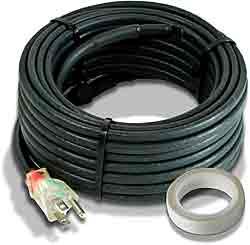 Pre-made heat tape is great to prevent freezing water lines. It’s a good option if you feel less than confident with the tools and know-how necessary to make your own heat tape cables. They are also a fine choice if they come in the length you need.
Pre-made heat tape is great to prevent freezing water lines. It’s a good option if you feel less than confident with the tools and know-how necessary to make your own heat tape cables. They are also a fine choice if they come in the length you need.
Custom-made heat tape cables can be a more economical choice if you need a long distance run or many cables of varying length.
Pre-made Heat Tape
I recommend this Heat Cable with Built-in Thermostat and 12 Feet of High-Temp Installation Tape by Radiant Solutions. There are other lengths available, but make sure you get one long enough to reach from the very bottom of your home to the very bottom of the water line pit.
Pipe Freeze Pro is a commercial-grade, self-regulating heat cable which provides years of reliable freeze protection for pipes of all varieties, including copper, steel, PVC, ABS, PEX and more (pipe diameters up to 2”). It may also be used in drains and culverts through the winter months to promote drainage. This is important because your wastewater line can freeze and plug too. Pipe Freeze Pro is jacketed with a commercial-grade fluoropolymer and comes standard with a flame-retardant thermoplastic interior jacket. The entire length of our cable is temperature sensitive such that colder areas demand more power than warmer areas. Radiant Solutions is a Minnesota-based company with expert support staff you can actually speak to! The cable has a commercial-grade outer jacket for long life and carries a FOUR YEAR WARRANTY. It will not short or burn out if the cable is overlapped.
Outdoor, freeze-proof faucet

The ground in my area freezes to a depth of 46″ during the winter. Our outdoor faucets look like this. These lead-free, cast iron faucets actually turn off the water at a depth of four or five feet to prevent freezing. Your heat tape must extend down the entire length of the faucet pipe. Once the tape is installed, you can fill the ‘water-pit’ with insulation or dirt. But it must be kept dry.
Custom-made Heat Tape Cables
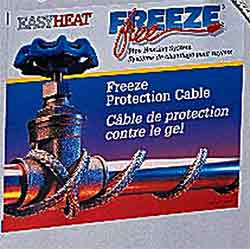
EasyHeat 2102 Freeze Free Heating Cable – 100′ provides flexible protection against pipe freeze-ups in the most challenging applications. The cut-to-length technology is ideal for installations that require protection of numerous pipes of varied lengths. The self-regulating effect of the cable reduces power consumption when the pipe does not require freeze protection. It is ideal for use on residential metal or plastic water supply and drain pipes subject to freezing temperatures; water supply lines underneath manufactured homes and tiny homes. The braided steel jacket prevents rodent chewing issues. Even though the box contains 100′ of cable; you’ll be surprised how fast you use it up. The current drain is about three watts per foot.
Here’s a 45′ length with the connector kit but it’s more expensive than buying the 100′.
You need to buy one that’s longer than your hose because there’s more to protect than just the hose.
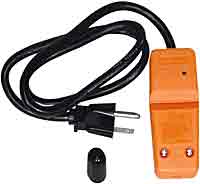
You will need a cable connector kit for each length of heat tape you make. These are very easy to make.
Other water lines to protect
Don’t forget the water line to your water heater if it is mounted externally. In Norway, they ran this heat tape alongside every water line in the small mountain cabin I visited. There was also a small, wall-mounted space heater on the wall of the utility closet to keep the water tank from freezing.
Wrapping the pipe with insulation is essential to prevent freezing water lines
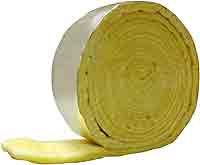
The final step is to wrap the pipe with insulation. This foil-backed insulation will maintain the temperature the heat tape creates. It is essential this is used. The heat tape will not be enough on its own to prevent frozen pipes in your tiny home.
Begin wrapping from the lowest section and overlap about a half inch. You can add some duct tape, but do not compact the insulation, as it only works when it’s puffed up. This is perfect for insulating faucets, pressure regulators, and in-line filters.
Most hardware and plumbing stores also carry this foam tube pipe insulation. It’s slit down the side and slips over the pipe, then tapes shut. This is what I used. Just make sure it has the diameter large enough for the pipe as well as the additional heat tape.
Here is a good YouTube® video showing the installation of heat tape under a mobile home to prevent freezing water lines
Heated water hose prevents freezing water lines
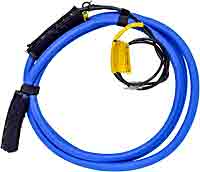
A pre-made heated water hose is the easiest thing you could do. Buy one only as long as you need and make sure they are safe for drinking water like this one. Heated Fresh Water Hose – 15′, Blue. This one has the best customer rating on Amazon.com, but all of the massed-produced cables have a high percentage of failure. Test it as soon as you get it.
The heating source is self-regulating, supplying additional heat as needed as the temperature drops – no thermostat is required. Heavy duty zippered insulation cuffs at each end are included for added freeze protection.
Shortcoming of a Heated Water hose
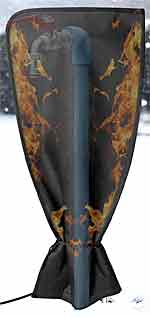
A heated water hose does not warm the faucet (unless you buy one of the expensive ones shown below). To get around this you will need the addition of a heated faucet cover like the one shown here.
This faucet cover uses an integrated heating wire and waterproof fabric to prevent freezing. It secures tightly with a drawstring and hook& loop fastener for complete protection in cold winters. It’s thermostatically controlled so it only comes on when needed.
I found it on Amazon but there are many non-electric faucet covers shown that are not heated. So, be careful when choosing one.
Heated hoses do not heat the faucets, so you might still have issues.
See how the heat tape is wrapped around the faucet in this picture of Easy Heat heat tape. Click on image to see more from Amazon.
You can run this cable along a non-heated water hose just like you would a pipe, or PEX. Insulate it just the same and you’ll be good to go.
I’ve heard that some RV parks do not allow DIY heated hoses for some reason.
Here’s a Premade industrial water hose You Can Depend On
These military-grade heated water hoses from NoFreezeWaterHose, are self-regulating and heat evenly along the entire length of the hose. You can plug them in on either end wherever your electric source happens to be. The best part is the heat cable can extend 12″ beyond the end of the hose so you can wrap around the faucets to keep them flowing freely too.
At most the heated water hose will use only 1.5 amps per 24′ length when it’s working.
These are a bit pricey but they work and keep working. They will double the warranty of any other heated hose you find.
Get a 5% discount using coupon code TINYLIFE at checkout.
Going Deep
In my state, the frost line is almost 48″ deep. The pipe from the faucet down into the ground needs to have heat tape too. This means digging out the pipe, wrapping with heat tape and insulation, then burying it again.
In some RV parks you see that the water pipe is already in a pit, or comes out of a PVC pipe. This water line also needs to be heated.
See the water pit in this screen shot from the video above. The end of the heat tape is kept above ground to prevent moisture from ever shorting out the tape. The heat tape is then run all the way down the water pit and back up. The pit can be filled with insulation in addition to wrapping the pipe.
The heat tape used is EasyHeat 2102 Freeze Free Heating Cable – 100′. It has a rodent-proof jacket on it.
Warming your Holding Tanks
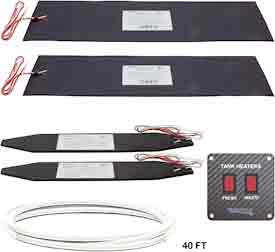
If you have grey, black, or freshwater holding tanks, they may require warming to prevent freezing. In mobile homes, the gray and black tanks are slung under the floor, exposed to the elements. These definitely need to be heated.
In a tiny home, you may have built them into the sub-floor. If you placed insulation between the tank and the lower sub-floor you might be OK without a heater. But the time to install the heater is before you finish the flooring. Many cold-weather veterans suggest letting the tanks fill and then draining them instead of leaving the drain valves open all of the time. See our page How to Drain and Maintain Your RV Holding Tanks for more information about this.
Facon 12″ x 18″ Water Holding Tank Heater Pad with Automatic Thermostat Control for RV Camper Trailer, 13.5V DC is intended for RV application and connects to a 12 volt battery. A power supply will be needed if you don’t have a 12 volt system in your tiny home.
If Your Holding Tanks Are Already Frozen
Try adding ice-melt (rock salt) and warm water to your gray and black tanks to melt the ice.
Propane Tank Heater
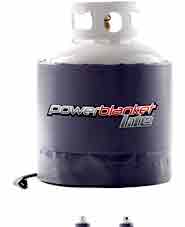
The Powerblanket PBL20 Gas Cylinder Heater is an insulated, band-style cylinder heater specifically designed to fit three different common gas cylinders. It can be used on standard 20, 30 or 40 pound gas cylinders. You can use one heater on the 20 or 30 pound cylinders and either one or two on the 40 pound. The heater is built for use with 120 volts AC, drawing 1, amp thus producing 120 watts. It has a preset thermostat set for 90 ºF / 32 ºC (± 10 ºF / 5 ºC). The PBL20 band style cylinder heaters allow you to draw propane at increased rates in cold weather conditions versus an unheated cylinder. This innovative heat-spreading technology insulates, protects, and maintains heat to help you keep your pressure up and reduce the frequency of cylinder refills.
Adding Heat to the Sewer Drain Hose
Adding a heated sleeve around your sewer hose prevents freezing in the drain line. This can give you peace of mind on cold winter nights. It’s especially useful if you decide to let your fresh water run a little bit (I don’t recommend that but some folks do).
You could also replace your sewer hose with a heated sewer hose so you don’t have to try and fit your existing hose into a sleeve. Note, however, that these inexpensive heated sewer hoses get bad ratings and are not regulated. They draw the max power the whole time their plugged in.
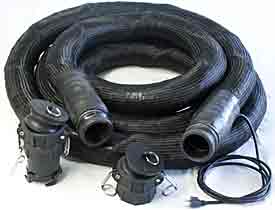
The best choice of a heated waste hose is, again, the NoFreezeWaterHose. These are industrial quality and guaranteed for twice as long as any other brand. These are regulated so they draw power only when needed the evenly throughout the length of the hose. Use coupon code TINYLIFE for a 5% discount.
If you keep your holding tanks closed until ready to drain this should not be needed. But, if you, for instance, want to leave your gray tank drain open because you take showers and do laundry that might overfill that tank, this might be a good idea.
See this page for more information on holding tanks: How to Drain and Maintain Your RV Holding Tanks
Leaving the Water Running, or Dripping In An RV
Think carefully before you let the water run or drip at the faucets in an attempt to keep your pipes from freezing. This method works in a house that has a regular sewer system but not in an RV.
If you do this in an RV you’ll need to leave your gray tank (possibly your black tank) valves open so they don’t eventually overflow. Unless you have a heated sewer hose this trickle of water will easily freeze. It can build up enough over time to plug the drain hose, then fill your gay holding tank, freeze that, and then bubble up into the shower and make a real mess.
At the very least the cold water in the pipes below the sinks will have condensation producing a damp area there leading to mold and other moisture issues.
Plugging in Heat Tape with Extension Cords
Heat tape generally comes with a two foot pigtail plugin. Unless you or your contractor built in an AC outlet near your water inlet, you will be using an extension cord to reach power.
Heavy Duty
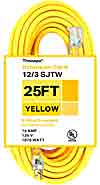
The extension cord needs to be able to handle the current draw of the heat without melting or restricting the current flow. The thickness of the copper wire should be 12 gauge or bigger. The lower the number, the bigger the wire. Buy an extension cord only as long as you need.
Tack the cable securely to your house near the outlet so it doesn’t pull out inadvertently. You can wrap the connection to the heat tape with some electrical tape.
Lighted Extension Cord
Outdoor outlets are usually a GFI type. This is a safety system that shuts off instantly if a short is detected to prevent electrocution. Unfortunately, they are so sensitive they sometimes trip off for no reason at all. A lighted extension cord, as the description reveals, has a light in the plug so you can easily see if the power is still on.
Connecting multiple heat tapes to one extension cord
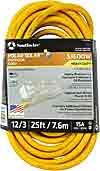
You can connect a few heat tape runs to the same extension cord if the cord is made for it. The cord shown here has three heavy duty outlets that can handle the amperage that will be drawn. This Coleman Cable 03487 12/3-Wire Gauge Tri-Source SJEOW Outdoor Vinyl Extension Cord, 25-Feet will work well.
Never use a power outlet adapter or a surge protector. They are not designed to handle the load or be outdoors.
Getting Extra Power for the heat tape
If you are in an RV park with a standard power pedestal, you can run your extension cord directly to the 20 amp outlet on the pedestal to tap an additional 20 amps to run the heat tape.
Preventing Your Norcold Fridge from Freezing
Older Norcold refrigerators that use a compressor and run on propane or electricity will need a cold weather kit allowing them to operate in ambient temperatures down to 0°F. The cold weather kit can be retrofitted to Norcold 6-, 8-, 10-, 12- abd 17-cu. ft.
One of the purchasers said that he needed to slide his refrigerator out about three inches. To do that he remove six screws and disconnected the propane line temporarily. A friend on Facebook said, “I also have to keep my fridge warm behind or it will freeze and quit working, it’s a Norcold. So I turn it to electric only cover the wall vents with the foil back bubble insulation and Velcro it in place. I added a fridge heater on coils made for cold weather for these refrigerators that’s thermostat controlled. I keep a 60 or 100 watt light in compartment and a 250 watt heater when it’s needed. I monitor temp with a remote thermostat.”
More Winter Living Tips
See more tips about winter living on this page: Winter Living, How to Prepare
Also see this page for staying warm in winter: Adding insulation and sealing your RV’s underbelly
Add Skirting
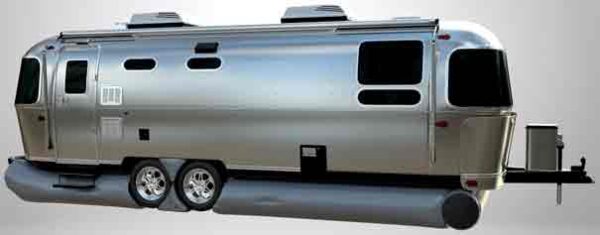
One of the most important things you can do to prevent freezing pipes with the added benefit of using less fuel and keeping your home much warmer is to add skirting. See my page on winter living for more information.
The image shows inflatable skirting.
For more information about Skirting visit this page: Skirting for Tiny Houses Travel Trailers RVs.




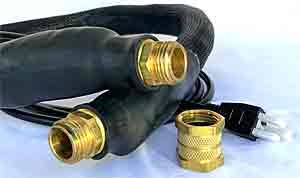
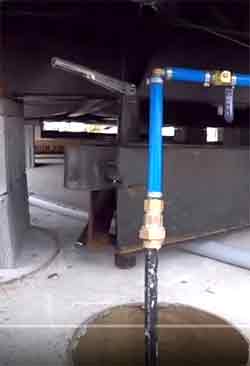
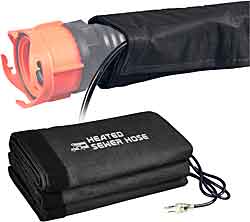
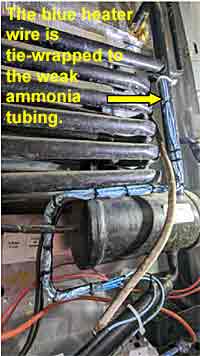


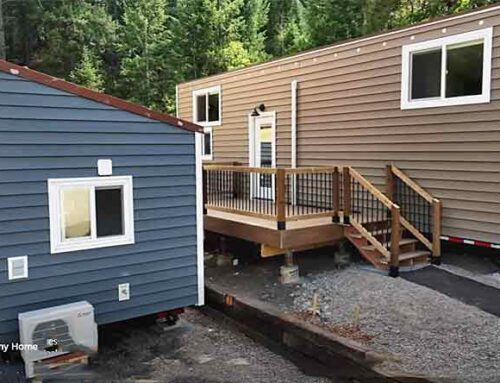
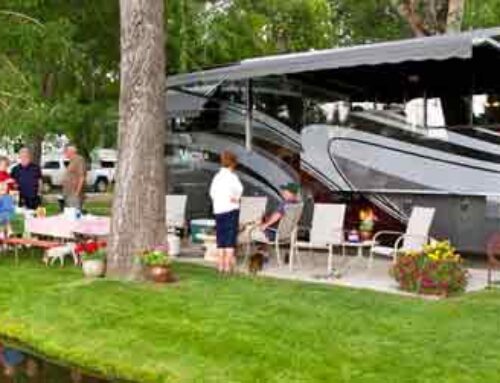
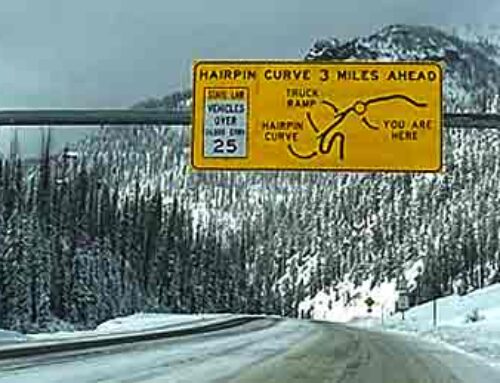
Heated water hose as incoming main feed works great. Plus I have it in a insulated 2″ PVC pipe for added insulation. Never seen the ” Box – O – heat tape” before, but I need that for drain pipes.